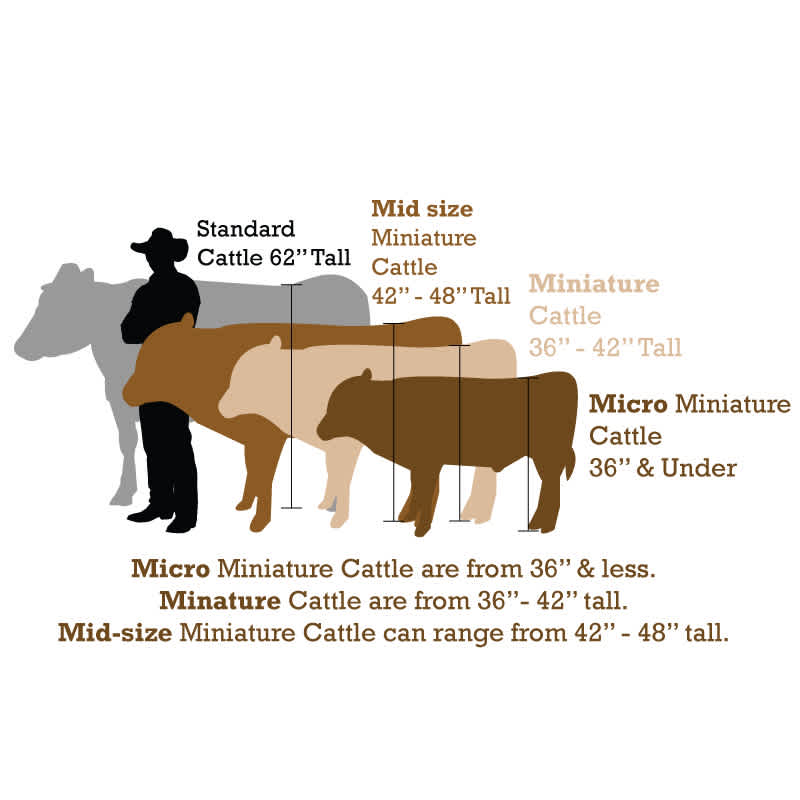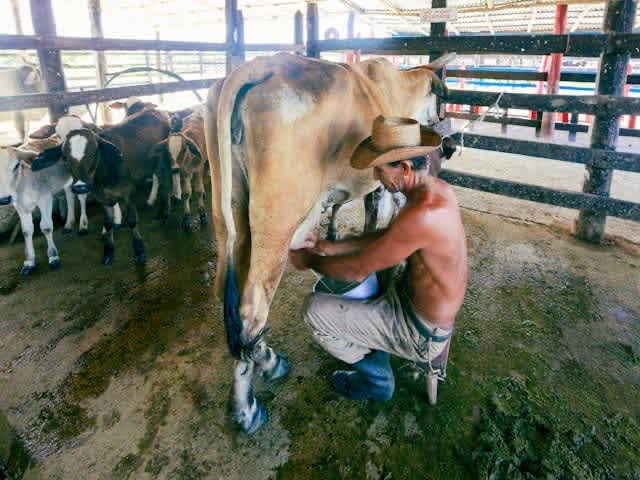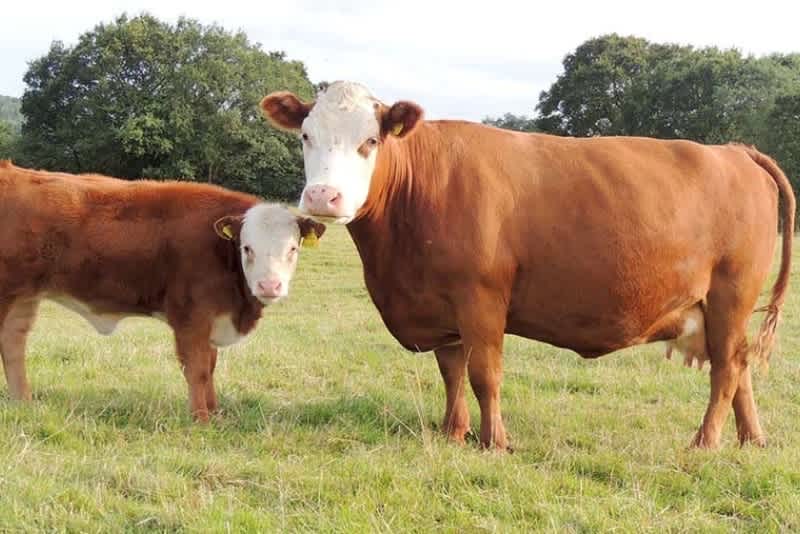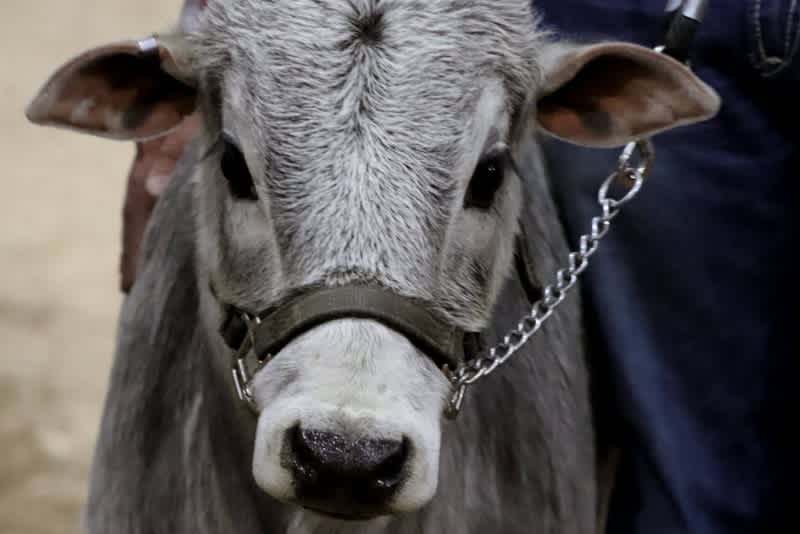Mini Cow Breeds: Everything YOU Need to Know for Successful Small-Scale Farming
Published: April 16, 2024

Miniature cow breeds have their own place on farms and even homesteads. If you're considering raising a few make sure you don't skip our guide.
They're not just about their adorable size; their docile nature and efficiency in milk and meat production make them particularly appealing for those with restricted farming areas.
But before you decide to bring one into your fold, it's vital to understand the unique considerations they entail, from housing to healthcare.
Let's explore what sets these miniature breeds apart and why they might be the perfect addition to your sustainable living efforts.
What exactly are small cow breeds?
Miniature cattle breeds, fundamentally scaled-down versions of standard cattle, offer a unique alternative by requiring less feed and space, producing a manageable amount of milk, and yielding meat sufficient for a small family.

You'll be pleased to know that mini cows aren't just about their compact size. Their dietary requirements are much less challenging as well. With mini cows (sometimes called teacup), you're looking at about a third less feed compared to standard cows.
Additionally, the pasture space they require is reduced, along with space for grazing. This makes them an ideal choice for you if you're aiming to maximize the utility of your small farm or homestead.
We'll get into more details below.
Characteristics of miniature cows: size, temperament, production
When it comes to selecting a miniature cow, it's important to consider their unique characteristics.
Small Cow Size
Mini cows are much smaller than standard cattle breeds. They typically stand between 36 to 42 inches tall at the shoulder when fully grown. Most smaller cow breeds weigh in the range of 650 to 950 pounds.
In comparison, regular cows are usually about 62 inches tall and weigh around 1,400 pounds on average. So mini cattle are roughly 1/3 the size of standard cows.
Mini cattle allow small-scale farmers and homesteaders to enjoy all the benefits of raising cows in a sustainable way.
Temperament
Mini cows are known for their friendly and social nature, making them a joy to be around. They have a gentle, docile temperament and often show affection towards their owners.
The smaller size of mini cows contributes to their calmer disposition compared to larger cattle breeds. This makes them safer and easier to handle, which makes them more ideal for those with limited livestock experience. Don't sleep on safety though. You'll still need to use regular precautions around them as they are still cattle after all!
Mini cows' approachable and agreeable personality, makes them an ideal choice for first-time farmers or those with limited space, ensuring a more enjoyable and less stressful experience in both care and companionship.
Milk Production

When it comes to milk production, mini cows also align more closely with the needs of a smaller household.
They produce 1 to 1.5 gallons of milk per milking, a stark contrast to the 6-8 gallons from a standard cow, which often exceeds what a typical family can consume.
Meat Production:
Small cow breeds are an efficient choice for meat production, especially for households with fewer members. Small breeds yield enough beef to feed a family of 4-6 for several months. This is much more manageable than the large amount of meat from a full-sized cow, which can be too much for a small family to store and consume before it spoils.
Did you know, a family of four typically consumes around 800 pounds of meat (chicken, pork, beef) in a year?
The average mini cow provides 220-440 pounds (100-200 kg) of meat, depending on the breed and individual animal. In comparison, a standard-sized beef cow yields 450-880 pounds (200-400 kg) of meat.
Small cow beef is known for being tender, flavorful, and lean. Many find the taste superior to standard beef cattle. The smaller cuts are also more convenient for packaging and meal sizing for farmers who want to sell direct to consumers. You can fill your freezer with a variety of steaks, roasts, ground beef, and more from a single mini cow.
For those wanting to raise their beef on a smaller scale, small cow breeds are a viable solution.
A list of Popular small cow breeds
When it comes to common miniature cattle breeds, you'll often come across these breeds: Miniature Herefords, Lowline Angus, Miniature Zebus, Miniature Jerseys to name a few.
Each breed has their own unique characteristics. Let's find out what they entail.
Miniature Herefords

Among the various popular mini cow breeds, Miniature Herefords stand out, originally developed through selective breeding in England and brought to fruition by the Largent family in 1974. This breed represents a full-blood Hereford line, meticulously crafted over three decades.
The Largent's initiative to downsize the traditional Hereford breed without compromising its quality and characteristics has been a significant contribution to the miniature cattle industry. Miniature Herefords maintain the robust and hardy nature of their full-sized counterparts, yet they require less space and food, making them ideal for smaller farms or those interested in sustainable farming practices.
Their friendly disposition and manageable size have also made them favorites among hobby farmers and those new to cattle raising.
Lowline Angus

Originating from the Angus cattle breed, Lowline Angus was bred in Australia to offer a compact, efficient alternative for both small-scale and sustainable farming operations.
The original breed emerged several hundred years ago from hornless cattle in the Angus and Aberdeen regions. In the 1970s, the Lowline Angus breed itself was developed. The Agricultural Research Centre in Trangie, Australia, played a pivotal role in their development.
Researchers focused on creating a smaller stature cow to make the breed more adaptable to various environmental conditions and farming practices.
Lowline Angus requires less pasture space and produces less waste, making them an ideal choice for those looking to minimize their ecological footprint.
They've since become popular among farmers seeking efficient, manageable cattle without sacrificing beef quality.
Miniature Zebu

While Lowline Angus offers a compact solution for sustainable farming, another notable option in the domain of mini cattle breeds is the Miniature Zebu, which traces its origins back to Asia.
Also known as Nadudana, these petite bovines are a miniaturized version of the larger Brahman cattle breed. Unlike their full-sized counterparts, Miniature Zebus boast shorter, sleeker coats and less prominent humps, making them distinctively different in appearance.
Their adaptability and smaller stature have made them a favored choice among small-scale farmers and those interested in sustainable livestock management.
Miniature Zebus carry with them a rich heritage, blending the robustness of traditional cattle breeds with the benefits of miniature size.
Miniature Jerseys

Miniature Jerseys, a more modern dairy breed (from the last 30–40 years), were meticulously downsized to their original stature after years of breeding for larger sizes. This trend of breeding larger animals was reversed as enthusiasts sought to reclaim the breed's historical size and efficiency.
Originating from Jersey Island, these mini cows have a rich history tied to their dairy production capabilities. They're known for their gentle temperament, making them excellent for small farms or as family pets.
Their adaptability and lower maintenance costs, due to their smaller size, contribute to their popularity among mini cow breeds.
Miniature Jerseys consume less feed than their larger counterparts, yet still produce a substantial amount of high-quality milk, about 2–6 gallons of high butterfat milk, rich in protein per day, making them a prized choice for those interested in sustainable farming practices.
Dexters
Let's turn our attention to Dexters, a versatile mini cow breed hailing from the Kerry region of Ireland.
Unlike their purely dairy-focused cousins, Dexters boast a tri-purpose utility: they're not only excellent milk producers but also provide tender, flavorful beef and can be used for draft work. This makes them an exceptionally practical choice for small farms and homesteads.
Their excellent foraging ability guarantees they make the most of pasture land, contributing to their high feed conversion efficiency. They are praised for their hardiness and adaptability to various climates.
This adaptability, combined with their ability to thrive on less, makes Dexters a sustainable option for those looking to maximize the utility of their livestock without needing a lot of space.
Belted Galloways (Belties):

Turning now to the Belted Galloways, also affectionately known as 'Belties,' we find a breed that's not only hardy but comes with a striking black and white color pattern reminiscent of an Oreo cookie.
Originating from the southwestern part of Scotland about 400–500 years ago, these mini cows have a notable history.
Their distinctive 'Oreo cookie' appearance isn't just for show; it's a reflection of the breed's legacy, making them easily recognizable among other mini cow varieties. This unique look was achieved by crossing native black Galloway cattle with Dutch Belted (Lakenvelder) back in the 18th century.
In the last few decades, breeders have selectively worked to downsize this breed, aiming to maintain their robust nature while adapting them for smaller farms or those looking for unique cattle options.
Today, Belties stand as a demonstration of the diversity and adaptability of mini cow breeds, with roots deeply entrenched in UK agriculture.
Raising mini cows: housing, feeding, healthcare needs
When you're considering raising mini cows, you'll need to focus on their housing, feeding, and healthcare needs.
Ensuring they have a comfortable shelter, a balanced diet, and regular veterinary care are key to their well-being.
Let's explore how you can meet these requirements to keep your mini cows healthy and happy.
Housing
When you're thinking about raising mini cows, you'll need to make sure they have adequate space, proper shelter, and secure fencing to keep them safe and healthy.
Addressing these aspects is key to successfully raising happy and healthy mini cows.
Space Requirements
Every mini cow needs at least 0.5 to 1 acre of outdoor space to graze and roam. This space is vital not just for their physical health but also for their mental well-being.
Ensuring they've enough room to move freely is essential in keeping your mini cows happy and healthy.
Shelter
In addition to the outdoor space requirements, it's also important to consider the type of shelter your mini cows will need.
They must have access to a well-ventilated area where they can comfortably lie down and sleep (that's right, cows sleep standing and lying down).
Make sure the shelter is spacious enough to accommodate all your cows, providing them with a safe and comfortable environment to rest and seek refuge.
Fencing
You'll have to make sure your mini cows are kept safe with proper fencing, such as five-foot-tall Tensile Fixed-knot wiring or sturdy four-foot fencing.
The fence must be visible to prevent the cows from accidentally running into it. This step is essential in ensuring their safety and maintaining your peace of mind.
Good fencing also helps in managing your mini cows' movements and keeping them within designated areas.
Feeding
When you're raising mini cows, comprehending their diet and nutritional needs is essential.
You'll need to guarantee they've constant access to clean water and the right balance of feeds to meet their specific health requirements.
Let's explore what constitutes an appropriate diet for these smaller breeds.
Diet & Nutritional Needs

While small cow breeds eat about 1/3 compared to a regular cow, they will still typically eat 2%–4% of their body weight per day. This of course varies depending on the breed and size of the cattle.
Roughage (hay and pasture) should make up the majority of the cow's diet. You'll want to, of course, give good quality pasture if possible. This also cuts down on the amount of acreage of pasture you need (higher quality equals less acreage and vice versa).
Limit Grains and concentrates to provide additional energy to support growth and milk production. Stay under 2.25% of their body weight when feeding grain to avoid health problems like acidosis.
These are all general guidelines and specific feeding schedules need to be established and adjusted to your specific cattle needs.
Consulting a livestock nutritionist or veterinarian allows you to create a fitting eating plan, ensuring they get the proper nutrients for their specific roles, whether that's providing meat or milk.
Water
As with most mammals, it's essential to emphasize that cows also need constant access to clean and fresh water to stay hydrated and healthy. They drink a lot, especially when they're active.
Small cow breeds can drink a very wide range of water from 5–30 gallons of water a day depending on the breed, age, weight, stage of their production, and the season and temperature outside.
You'll want to make sure their water supply is always available and uncontaminated to keep them in top health. This is vital for their overall well-being.
Healthcare
Healthcare needs in cattle include regular veterinary care and hoof maintenance. It's also vital to monitor their health closely and understand their social needs and breeding considerations. These steps guarantee your mini cows lead healthy, happy lives.
Veterinary Care
Prioritize regular veterinary care, including check-ups, deworming, and vaccinations. Make sure you speak with a veterinarian who's experienced in treating cattle.
This professional can help schedule these important health maintenance activities for your mini cow.
Hoof Care
Proper hoof care is essential for your mini cow's mobility and overall health. This care requires regular checks and maintenance ranging 3–6 months to prevent issues such as overgrowth and lameness. Neglecting this can cause pain and affect their well-being.
Here are just a few variables to consider frequency in cattle hoof care:
Age - older cows may need more frequent trimming
Lactation stage - trimming is recommended before dry off and at mid-lactation (120 days)
Housing environment - cows moving around on harder services more often will need more frequent trimmings.
Breed - some cows are just more prone to hoof problems due to their genetics.
It's vital to stay diligent with their hoof health, ensuring they remain happy, healthy, and active. Regular trims are a key part of their care routine.
Monitoring Health

Regularly monitoring your mini cow's health is essential for early detection of any issues, ensuring they receive prompt and effective care.
Watch for signs of illness like lack of appetite, lethargy, limping, diarrhea, and coughing. If you notice anything abnormal, don't hesitate to call your vet immediately.
One convenient way to track all these changes is by using detailed cattle management software that can track pregnancies and health notes, and that you can carry in your pocket.
Social Needs
After ensuring your mini cow's health through vigilant monitoring, it's equally important to address their social needs to maintain their overall well-being.
Mini cows are social creatures that thrive in the company of their kind. You can keep a group of females together without males, as they get along fine without a mate.
Breeding Considerations
When considering breeding mini cows, it's important to understand the healthcare challenges they may face, including the risks of breeding cattle affected with Chondrodysplasia. If you're not careful, and two carriers are bred, their calves could face fatal conditions.
It's vital to get your mini cows genetically tested to avoid such risks.
Equipment
To ensure your mini cows thrive, it's important you consider specialized healthcare equipment tailored to their unique size and needs. Since they're smaller, standard tools may not suffice.
You'll need appropriately sized gear like:
lowered feeders
smaller barns - ensuring they can comfortably access food and shelter
water setup - troughs and large containers that match their height. Can also consider automatic waterers
handling equipment - halters, lead ropes, trailers, squeeze shutes with proper sizing
milking equipment that fits mini cows if needed
This attention to detail helps prevent injuries and promotes better health, making your mini cow care more effective and efficient.
Our mini journey concludes
To wrap up, mini cow breeds like Miniature Herefords and Lowline Angus offer a great solution if you're tight on space but dream of sustainable farming. They're not just adorable; they're practical, needing less feed and land, and they're easier to handle due to their docile nature.
Before diving in, make sure to check local regulations and make sure you're set up for their care. Embracing these pint-sized cattle could be the perfect step towards a more manageable and eco-friendly homesteading lifestyle.
Keep track of all your cattle with the #1 Cattle Management Software
Try out Ranchr today for free